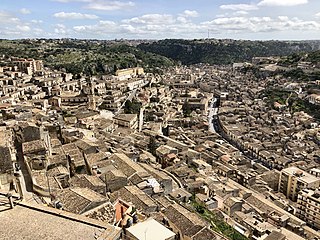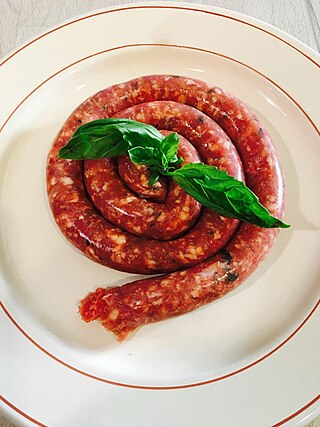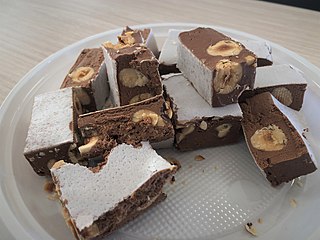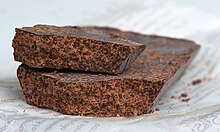
Mascarpone is a soft Italian acid-set cream cheese. It is recognized in Italy as a prodotto agroalimentare tradizionale.

Caciocavallo is a type of stretched-curd cheese made out of sheep's or cow's milk. It is produced throughout southern Italy, particularly in the Apennine Mountains and in the Gargano peninsula. Shaped like a teardrop, it is similar in taste to the aged southern Italian provolone cheese, with a hard edible rind.

Bottarga is a delicacy of salted, cured fish roe pouch, typically of the grey mullet or the bluefin tuna. The best-known version is produced around the Mediterranean; similar foods are the Japanese karasumi and Taiwanese wuyutsu, which is softer, and Korean eoran, from mullet or freshwater drum. It has many names and is prepared in various ways.

Toma is a soft or semi-hard Italian cow's milk cheese, noted for its excellent melting qualities. It is made primarily in the Aosta Valley and Piedmont regions of Northwestern Italy. Toma varies with region and locale of production, and is closely related to the French tomme.

Modica is a city and comune of 54,456 inhabitants in the Province of Ragusa, Sicily, southern Italy. The city is situated in the Hyblaean Mountains.

Venchi is an Italian gourmet chocolate manufacturer founded by chocolatier Silviano Venchi. After its establishment in Turin in early 1878, the company expanded throughout Italy with its Nougatine, small candies made of crushed and caramelized hazelnuts coated in dark chocolate.

Swiss chocolate is chocolate produced in Switzerland. While cacao beans and other ingredients such as sugar cane originate from outside Switzerland, the actual production of the chocolate must take place in Switzerland. Switzerland's chocolates have earned an international reputation for high quality with many famous international chocolate brands.

The cuisine of Sardinia is the traditional cuisine of the island of Sardinia, and the expression of its culinary art. It is characterised by its own variety, and by the fact of having been enriched through a number of interactions with the other Mediterranean cultures while retaining its own identity. Sardinia's food culture is strictly divided into food from the land and food from the sea, reflecting the island's historical vicissitudes and especially its geographic landscapes, spacing from the coastline to the ragged mountains of the interior. The Sardinian cuisine is considered part of the Mediterranean diet, a nutritional model that was proclaimed by UNESCO as an intangible cultural heritage.

Caffarel is a chocolate-manufacturing company based in Luserna San Giovanni, Italy, which is a subsidiary of Lindt & Sprüngli. The company was founded in Turin during the 19th century. According to the company, it was founded in 1826 when Pierre Paul Caffarel (1801–1871) converted an ex-tannery into a chocolate factory and invented Gianduiotto in 1852.
Torta setteveli is a seven-layer cake. Traditionally served at birthdays, it includes chocolate and hazelnuts.

The Hyblean ricotta is a dairy product derived from the whey produced in Libero consorzio comunale di Ragusa and is recognized as prodotto agroalimentare tradizionale since 2000.

Neccio, also called niccio, ciaccio, or cian, is a galette made with chestnut flour, typical of some mountain zones of Tuscany and Emilia, in Italy, and on the island of Corsica, in France.
The Antica Dolceria Bonajuto is a chocolate factory founded in Modica in 1880, known to be the oldest in Sicily and one of the oldest in Italy and for having been frequented by illustrious people of international fame.

Alprose is a Swiss chocolate producer based in Caslano (Ticino). It was founded in 1957 under the name Titlis SA and received its current name in 1983.

The Fabbrica di Cioccolato Cima Norma S.A., also Chocolat Cima-Norma S.A., in Torre-Dangio was an industrial chocolate production company in the canton of Ticino. It was founded in 1903 by the Cima brothers. It went bankrupt in 1968. The company Cima Norma S.A. also stands for the economic development and modernization advancement goal from the beginning of the 20th century for the mountain valley Blenio Valley, which was classified as a peripheral region.

Zampina di Sammichele is a cold cut awarded the Italian designations of origin: prodotto agroalimentare tradizionale (PAT) and De.Co.

Torrone Nurzia, also called torrone tenero al cioccolato aquilano, is a type of nougat from Abruzzo, Italy.

The Siracusa–Gela–Canicattì railway is a single-track line in Sicily, Italy managed by RFI. The route connects Syracuse on the Ionian side of Sicily to the Mediterranean side, crossing, with an east-west route, a number of large urban centers to Canicattì.
Casàda is a typical dish from Primiero, in Trentino, Italy; it is prepared in two versions: casàda con la tenza and casàda con la pojna.


















